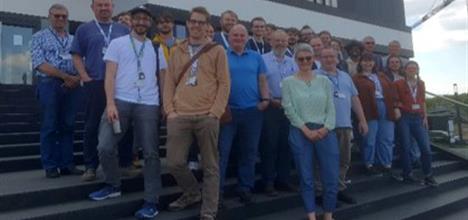DiPOLE100X (D100X), a laser we were recently commissioned to build, has smashed all expectations during its first official experiment at the European XFEL in Hamburg, Germany.
It has been reported that the quality and quantity of the data from D100X has exceeded previous FEL experiments, and has given some exciting data to over 30 collaborating institutions in the experiment to analyse.

The collaborators on the experiment.
The DiPOLE concept laser system, which was designed to be compact, yet able to deliver high powers at high repetition rates, was shipped over to Hamburg in 2019. This cutting-edge ability, jointly funded by STFC and EPSRC, will be available for all users at the end-station and will be jointly supported by the CLF as part of the Helmholtz International Beamline for Extreme Fields (HIBEF) user consortium. CLF scientists worked with the European XFEL staff to install, test and train local staff on how to use the laser. Following this, it was with great excitement and anticipation that we watched D100X's first collaborative user community experiment happen back in May of this year.

Photos from the chambre. Image Credit: HiBEF
The experiment explored the shock compression of a whole range of different materials, creating pressures inside the shocked targets exceeding 2 Mbar – comparable to the centre of the Earth. While not operating at its full energy and repetition rate quite yet, the D100X laser delivered up to 40J of energy per pulse at up to 1Hz, generating highly reproducible data at a rate not previously possible.
Professor Malcolm McMahon of the School of Physics and Astronomy at the University of Edinburgh was Principal Investigator on the first D100X experiment. He said:
"The first experiment at the European XFEL using DiPOLE [D100X] was a great success, perhaps more successful than we had dared to hope for. The aims of the experiment were very ambitious, yet we obtained exciting new data in all three science areas. Reaching 1 Hz operations was a particularly important achievement as this opens the future possibility of studying very weak scattering phenomena by collecting and summing the data from 100s or even 1000s of individual shots. DiPOLE worked almost flawlessly with the European XFEL, and the whole international community is now excited to use the system again"
Once fully ramped up, D100X will have the ability to shoot at 10 Hz, 3 orders of magnitude faster than other comparable systems, greatly increasing the scope of the science that can be conducted.
More about the division that created DiPOLE, here.
News from: https://www.clf.stfc.ac.uk/Pages/D100X-exceeds-all-expectations-on-first-experiment.aspx


